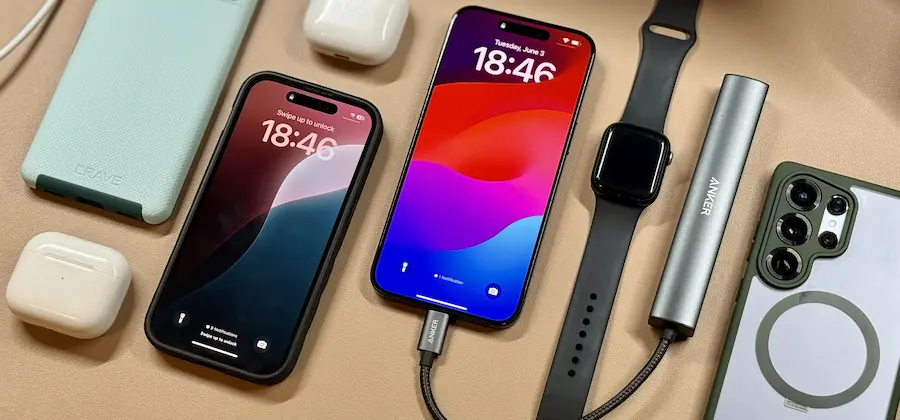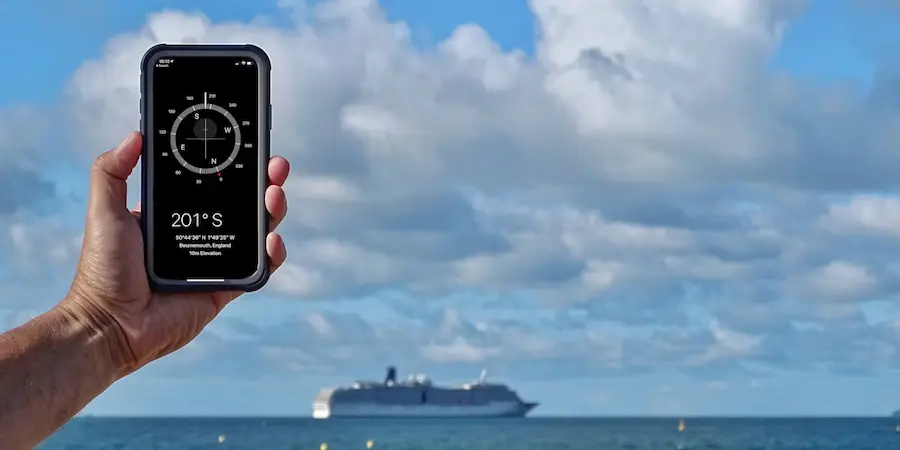The iPhone Compass app goes unnoticed among Messages or Photos, but it’s one of those tools that, when you master it, gets you out of trouble both in the mountains and in the city. It works offline thanks to the device’s GPS and magnetometer, so it doesn’t depend on cellular coverage. You can also enable Airplane Mode or Low Power Mode to extend battery life, and download offline maps in Maps before you head out. Who said you needed data to orient yourself?
Although we show it here as it appears in iOS 18, its operation is very similar in earlier versions: everything is on a single screen, with real-time readings and shortcuts to what really matters when you’re moving on the ground.
Accurate readings, even without data
The Compass displays your current heading alongside a degree value you can use as an azimuth. This allows much more precise travel in open areas with few references, and is key for activities like hiking, sailing, skywatching or piloting drones, where controlling heading by degrees makes the difference — yes, as if you were carrying a pocket Garmin or fine-tuning the nose of a DJI drone.
If a track asks you to follow 215°, turn until the number appears at the top; the app readjusts instantly as you move. For the most reliable reading, keep the iPhone level and center the sights. Bear in mind that the magnetometer can be affected by nearby metal objects, electronics, magnetized surfaces or even underground minerals and power lines; if you suspect interference, move a few meters and take another measurement.
The dial clearly marks the cardinal points (N=0°, E=90°, S=180°, W=270°) and, next to the degree, you’ll see the corresponding intercardinal point (NE, SE, SW, NW). These cover ranges: for example, NE corresponds to 45° ± 22.5° (from 22.5° to 67.5°), which helps refine your route when you don’t need surgical precision.

Heading lock and true north vs. magnetic north
Having trouble holding direction between junctions or on a ridge? Tap the dial to lock your heading. The app draws a red arc if you deviate, visually guiding you back to the locked direction. This trick is gold on routes with few landmarks, when skiing off-piste, paddling or crossing deserts, where sight alone isn’t always enough.
Another key choice is whether to use true north or magnetic north. True north is aligned with the geographic pole and is the standard on topographic maps and GPS devices, so it’s useful if you navigate with precise cartography. Magnetic north, on the other hand, is what traditional compasses show and varies by area due to the drift of the Earth’s magnetic field; if you practice orienteering with an old map or classic techniques, this setting is the one to use.
You can change it in Settings, in the Compass section, by toggling “Use True North” on or off. If you opt for true north, also make sure Compass Calibration is enabled in the system Location settings. With these options properly configured, readings will be consistent with your map or with the physical compass you carry in your pack.
Coordinates, altitude, level and Apple Watch
At the bottom you’ll see your latitude and longitude coordinates, which place your exact position on the planet. For maximum accuracy, enable “Precise Location” in Location settings. Tapping the coordinates opens your location directly in Apple Maps if you need directions; long-pressing lets you copy them to the clipboard or have the iPhone read them aloud. In an emergency, sharing these numbers with rescue teams is the clearest way to say “I’m here.” Just below, the app shows the name of the place where you are, useful for identifying landmarks or waypoints.
The Compass also displays your altitude above sea level, estimated by the iPhone’s barometric altimeter, which infers changes from atmospheric pressure. This data is very valuable for planning breaks, managing effort on steep sections and anticipating altitude-related conditions (colder, less oxygen and rapidly changing weather). Due to weather, accuracy can fluctuate, so on critical routes it’s wise to cross-check with a dedicated altimeter.
Need to level a piece of furniture or a picture frame? The iOS Measure app has included a digital level since iOS 12, but if it ever fails, the Compass’s sights can serve as an emergency tool to check flat surfaces on the go.
If you wear an Apple Watch, the ecosystem gets even more interesting: you can create waypoints to mark your car or the trailhead and check them later, record relative altitude, and enable Backtrack to retrace your steps if you get disoriented. The watch can even save the last point with cellular coverage or where you were able to make an emergency call, and it notifies you when you exceed an altitude threshold you set, ideal for gradual acclimatization. Use the Digital Crown to change views (for example, heading arrow or waypoint grid) and, from the Watch settings, adjust options like “Use True North,” Backtrack behavior during workouts and the coordinate system (decimal degrees, DMS, MGRS/USNG or UTM). The true north setting syncs between iPhone and Watch, so changing it on one applies it to both.
In short, the iPhone Compass is much more than a pretty wind rose: it’s a Swiss Army knife for orienting yourself, planning and gaining safety. With a few gestures, you go from “which way do I go?” to knowing exactly where you are, where you’re headed and how to get back if necessary. And all of that even far from the last bar of coverage.

